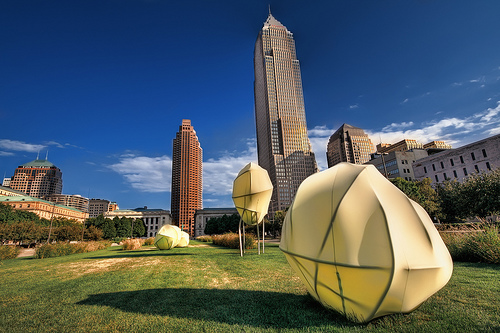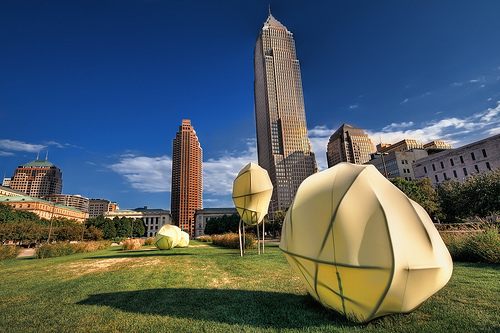 The most climate-resilient U.S. city might surprise you.Photo: Scallop HoldenCross-posted from Cool Green Science.
The most climate-resilient U.S. city might surprise you.Photo: Scallop HoldenCross-posted from Cool Green Science.
Earlier this month, 35 mayors from major cities around the world convened for the Resilient Cities 2011 Conference and released a declaration [PDF] that highlighted the recent rise in natural disasters and the imperative for cities to increase their resiliency and ability to adapt to climate change.
But what does it mean for a city to be “resilient” to climate change? Which cities are most resilient — and what makes a city vulnerable?
Grist recently ran a slideshow featuring “the top 10 climate ready U.S. cities” — which was basically a measure of steps those cities were taking to reduce carbon emissions. What that piece didn’t address is how vulnerable or resilient a city is to climate change based on the city’s environmental context. For instance: What’s a city’s risk for climate-related disasters? Is its water supply sustainable?
I haven’t seen such a ranking — so I constructed my own simple one, based on readily available and relevant information. (You can peek at the results below.) I first factored that cities’ biggest concerns from climate change include disruptions to water supplies, increased risk of natural disasters (e.g., floods and hurricanes), and the heat itself: In addition to causing general discomfort, heat is already the biggest weather-related source of mortality.
Note that my rankings are not based on forecasts of future conditions. Instead, I assumed that cities that today have low risk of heat stress, natural disaster, and water supply disruption would, all things being equal, be relatively less impacted by climate change than other cities under various climate-change scenarios. (Here’s a separate post on my methods if you want to dig into how I justify this.)
Drum roll please: The top five U.S. cities that are most resilient/least vulnerable to climate change are: Cleveland, Milwaukee, Detroit, Chicago, and Minneapolis.
The bottom five (the least resilient/most vulnerable) are: Phoenix, Houston, Sacramento, Las Vegas, and Miami.
Why do Rust Belt cities do so well in my rankings? Because they have a sustainable water supply (in four of the cities, the Great Lakes); their heat stress rankings are relatively low; and they are less vulnerable to natural disasters that will be exacerbated by climate change, such as floods, landslides, and wildfires.
One obvious observation is that the most climate-vulnerable cities include some of the fastest growing regions of the country, while the most climate-resilient include several cities with flat or even declining populations. So the country’s population is shifting away from places that are better-equipped to deal with climate change and toward areas that may face the greatest disruptions from climate change. Many of the most resilient cities are former industrial giants in need of new economic drivers. Transforming our economy to one that runs on much cleaner energy will require significant expansion of “green industries” with associated job growth. So, despite the relatively lower vulnerability of the Clevelands and Milwaukees and Detroits of the world, these cities should still pursue the investments required to prevent climate change. Those investments could provide an important spark for economic revitalization.
| Rank | City | Water Supply Sustainability | Heat Stress | Natural Disaster Risk | Overall |
| 1 | Cleveland | 1 | 12 | 3 | 5.3 |
| 2 | Milwaukee | 1 | 22 | 1 | 8.0 |
| 3 | Detroit | 4 | 19 | 8 | 10.3 |
| 4 | Chicago | 1 | 21 | 12 | 11.3 |
| 5 | Minneapolis | 9 | 23 | 8 | 13.3 |
| 6 | Indianapolis | 11 | 10 | 25 | 15.3 |
| 7 | Atlanta | 17 | 13 | 18 | 16.0 |
| 8 | Seattle | 27 | 6 | 16.5 | |
| 9 | Nashville | 23 | 15 | 17 | 18.3 |
| 10 | Jacksonville | 7 | 17 | 32 | 18.7 |
| 11 | Kansas City | 19 | 18 | 21 | 19.3 |
| 12 | Omaha | 20 | 20 | 19 | |
| 13 | Columbus | 12 | 9 | 39 | 20.0 |
| 14 | Colorado Springs | 43 | 11 | 7 | 20.3 |
| 15 | Philadelphia | 22 | 32 | 8 | 20.7 |
| 16 | San Francisco | 38 | 5 | 21.5 | |
| 16 | Oakland | 39 | 4 | 21.5 | |
| 18 | Portland | 28 | 8 | 30 | 22.0 |
| 19 | Long Beach | 44 | 1 | 22.5 | |
| 20 | New Orleans | 5 | 14 | 49 | 22.7 |
| 20 | Baltimore | 15 | 25 | 28 | 22.7 |
| 20 | Memphis | 6 | 27 | 35 | 22.7 |
| 23 | Boston | 14 | 24 | 32 | 23.3 |
| 24 | San Antonio | 26 | 29 | 16 | 23.7 |
| 25 | San Diego | 45 | 3 | 24.0 | |
| 25 | Los Angeles | 46 | 2 | 24.0 | |
| 27 | San Jose | 42 | 7 | 24.5 | |
| 28 | Washington | 21 | 26 | 27 | 24.7 |
| 28 | Louisville | 18 | 30 | 26 | 24.7 |
| 30 | New York | 29 | 16 | 32 | 25.7 |
| 31 | El Paso | 34 | 44 | 3 | 27.0 |
| 32 | Charlotte | 25 | 28 | 29 | 27.3 |
| 32 | Tulsa | 8 | 35 | 39 | 27.3 |
| 34 | Honolulu | 10 | 47 | 28.5 | |
| 35 | Dallas | 33 | 31 | 22 | 28.7 |
| 35 | Denver | 40 | 33 | 13 | 28.7 |
| 35 | Oklahoma City | 13 | 34 | 39 | 28.7 |
| 38 | Austin | 24 | 43 | 20 | 29.0 |
| 39 | Arlington | 30 | 36 | 22 | 29.3 |
| 40 | Virginia Beach | 16 | 38 | 35 | 29.7 |
| 41 | Fresno | 36 | 46 | 8 | 30.0 |
| 42 | Fort Worth | 31 | 40 | 22 | 31.0 |
| 43 | Tuscon | 47 | 45 | 3 | 31.7 |
| 44 | Albuquerque | 41 | 42 | 14 | 32.3 |
| 45 | Mesa | 48 | 49 | 1 | 32.7 |
| 46 | Phoenix | 49 | 50 | 3 | 34.0 |
| 47 | Houston | 32 | 37 | 43 | 37.3 |
| 47 | Sacramento | 35 | 39 | 38 | 37.3 |
| 49 | Las Vegas | 50 | 48 | 15 | 37.7 |
| 50 | Miami | 37 | 41 | 50 | 42.7 |
Although minimizing climate change must be a national and global priority, a certain amount of change may already be locked in. Cities — even those that are relatively less vulnerable — should begin preparing for changes in temperatures, water supply, and natural disaster risks (e.g., read about Chicago’s adaptation efforts).
However, Sharon Begley recently reported in Newsweek that adaptation plans are the exception, not the rule. One promising strategy is “ecosystem-based adaptation” — using the “natural infrastructure” of forests, floodplains, wetlands, and coral reefs to regulate water supplies and reduce disaster risks. For example, floodplains can hold floodwaters, reducing flood risks to cities and farms. A primary benefit of ecosystem-based adaptation strategies is that they provide a multitude of benefits, and thus can be considered “no regret” options (meaning they provide benefits even if climate change impacts don’t occur).
For example, although sea walls’ only benefit is the prevention of coastal erosion — and these expensive structures are often undermined and cause a variety of problems — mangrove forests can protect coasts while also providing critically important nurseries for fish and shellfish, habitat for birds and other animals, and absorbing carbon dioxide.
Bottom line: Each city faces different challenges from climate change. Some may have greater resilience, but they still will need to adjust to changing conditions. And all should follow the example of the innovative cities profiled in Grist’s recent slideshow — cities that are leading the way toward a lower-carbon and more sustainable future … and reaping great savings and job growth along the way.



